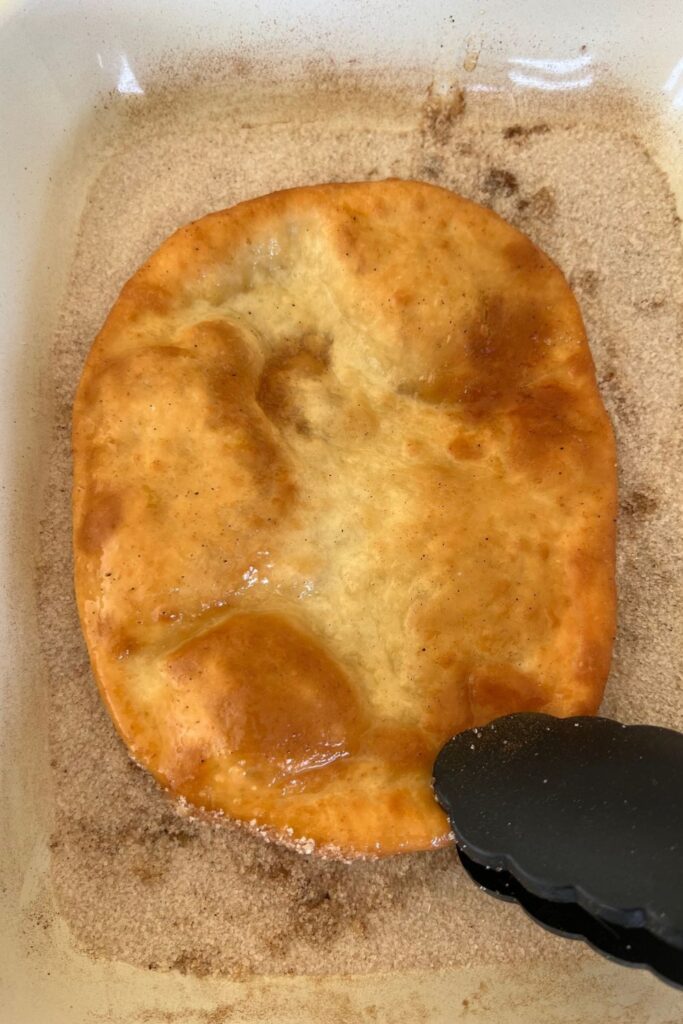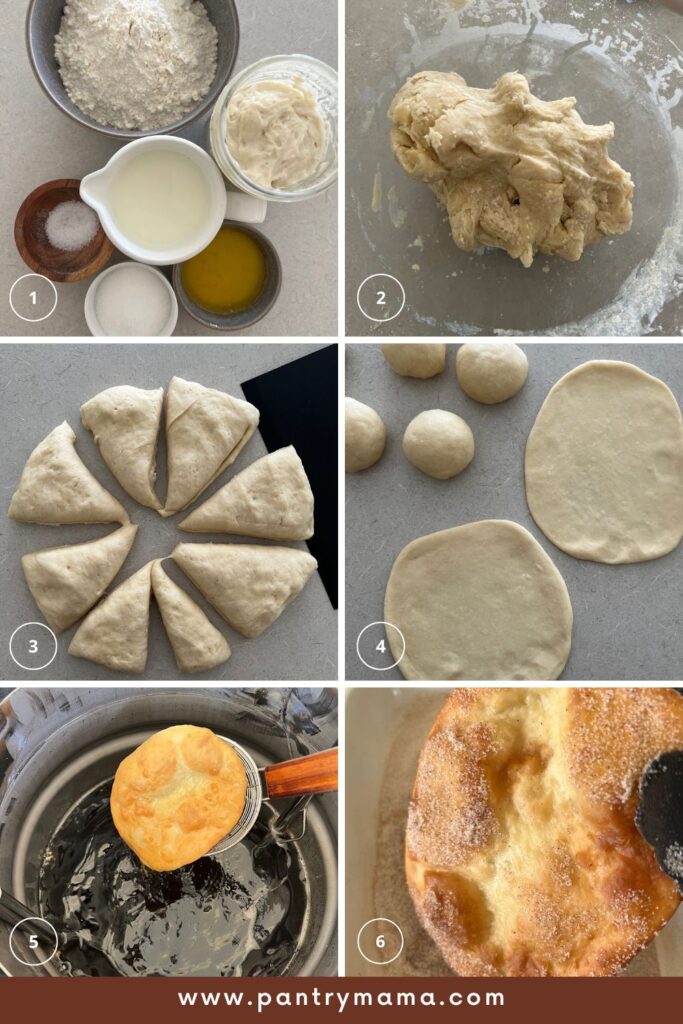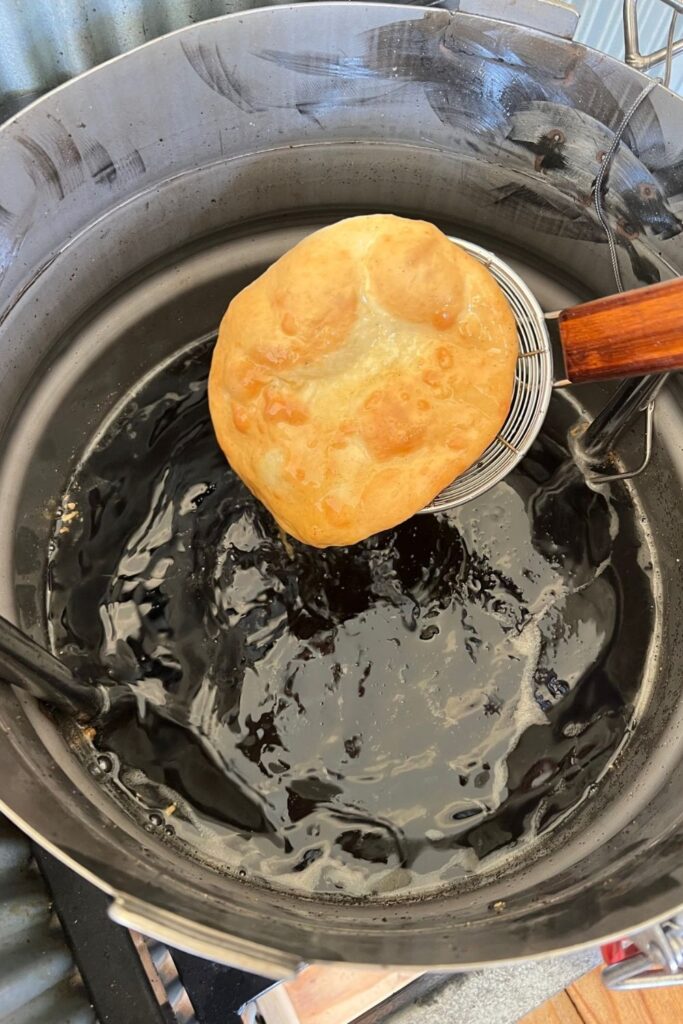Sourdough Elephant Ears
This post may contain affiliate links.
Sourdough elephant ears are a take on the American fairground classic but in this version you add some sourdough starter or sourdough discard to give them a flavor twist!
This sourdough fry bread is deep fried in oil and dusted in cinnamon sugar. They can be served with chocolate sauce, nuts, ice cream or whatever you fancy!
This simple fried sourdough dessert brings all the flavor of the fair right into your own kitchen and allows you to add some sourdough tang to an American favorite.
If you love fried sourdough treats, you might also love making sourdough banana fritters or even these sourdough onion rings!

What Are Fried Elephant Ears?
Elephant Ears are made from a yeasted dough that is shaped into circles and deep fried then dusted in cinnamon sugar or powdered sugar. They are most popular at country fairs and carnivals in mid west America.
There are a few versions of elephant ears floating around - some use yeast, some don't. Adding yeast does lengthen the process of making elephant ears, however I think that the texture and flavor is much better this way.
Elephant ears can also be called fry bread, bunuelos, doughboys or Palmiers (although these are shaped a little differently).
When the yeasted dough hits the hot oil, it bubbles and wrinkles and comes out looking somewhat like a big old elephant ear - hence the name.
You can read more about the history of elephant ears here.

How To Make Sourdough Elephant Ears
The process of making sourdough elephant ears is fairly simple.
The dough is a low hydration dough that is left to rise for a while and then shaped, rested and fried. You can choose to make these with active sourdough starter or sourdough discard with some commercial yeast added.
Here's how to make delicious sourdough elephant ears:
- Pour warm milk, melted butter and sugar into a large bowl and mix together to dissolve the sugar.
- Add the dried yeast if you are using and allow it dissolve and foam.
- Now add the flour, salt and sourdough starter to the mixture and stir into a dry, shaggy dough.
- Use your hands to bring the dough together and pick up all the dry bits of flour. If you feel the dough is super dry at this point, add a splash more milk.
- Tip the dough out onto the counter and knead until it's soft and supple.
- Place the kneaded dough into a bowl and cover with plastic. Allow the dough to rise.If you're using commercial yeast with sourdough discard, this will only take 1 to 2 hours in a warm environment.If you are using just active sourdough starter, this could take anywhere from 4 to 8 hours. The dough doesn't have to double, just rise by at least 50% and be puffy.
- Once the dough has risen, divide the dough into equal pieces. As these are a rustic type snack, they don't need to be weighed, however if you want to you definitely can.
- Shape the dough into rough balls and allow the dough to rest for around 10 to 15 minutes on the counter.
- Heat your choice of oil in a large pot (I use rice bran oil or vegetable oil). You want the temperature of the oil to be around 170C.
- While the oil is heating up, roll the balls out into "elephant ear" shaped pieces.
- Add the cinnamon, sugar and salt to a bowl to create the cinnamon sugar and have it close to the oil so you can dip the fried ears straight in.
- When the oil has reached temperature, gently place one or two pieces of dough in at a time (depending on the size of your pot). Allow them to cook for a few minutes, turning once or twice, until they are golden brown.
- Carefully remove from the hot oil and dip into cinnamon sugar.
- Serve while hot and crispy.

Best Tips For Success
This is a fairly simple dough to make, but there are a few things you can do to make sure you have success every single time!
- The consistency of your dough will depend on the active starter or discard you use. If your starter is thicker, the dough will feel drier. If it's runnier, the dough might be wetter. This is a really forgiving dough, but you want it on the drier side - it should NOT be sticky at all!
- It's ok to add a little more flour or a little more milk if you feel the dough needs it.
- Don't let the oil get too hot or the elephant ears will be hard and crunchy. You want a crispy outside with a soft, tender inside.
- If you're using active starter, the dough will take a while to ferment as it's a lower hydration dough. Keep it warm and give it time to rise. It doesn't have to double, just rise by around 50%.
- The size you make your elephant ears will depend on the size of your pot of oil. For this recipe I divided the dough into 70g pieces but you can make them bigger or smaller to suit your needs.

Frying Elephant Ears
There are a few ways you can fry these sourdough elephant ears.
You'll see in the photos that I am frying these in a huge pot of oil. This is an outdoor deep fryer used for fish and french fries but at the time of photographing we were going through a kitchen remodel so I had to cook these outside. I'm using 9L of rice bran oil.
Normally, I fry these sourdough elephant ears in my Dutch Oven filled with 2L of vegetable oil and they work fine. This is an easy way to make these sourdough fry breads inside in your own kitchen.
You can use any type of oil you prefer. I've used rice bran oil and vegetable oil with no problems.
Make sure you have a metal scoop that can withstand hot oil to scoop the elephant ears out.

How To Eat Sourdough Elephant Ears
The best way to eat these sourdough elephant ears is to dust them with cinnamon sugar or powdered sugar and enjoy them immediately after cooking.
If you want to take them to the next level, you could also add some toppings - my family love to serve these as a "dessert platter" where everyone can choose their favorite toppings. Some of our favorite ways to top these sourdough fry breads are:
- Vanilla ice cream, chocolate sauce and walnuts.
- Fresh strawberries and whipped cream.
- Canned apples, toasted pecans and caramel sauce.

Using Your Sourdough Starter In This Recipe
You'll need to use your sourdough starter for this recipe - but there are a few things to consider when deciding how and when to use it.
If you have a newly established sourdough starter that is less than 3 months old, I recommend using some commercial yeast with your sourdough discard.
If you have a mature sourdough starter that is well developed and makes great bread (generally more than 3 months old) you'll find that you don't need to use commercial yeast and you can use active sourdough starter.
Of course, if you still want to add a little yeast for a quicker rise, you most certainly can.
Useful Equipment for Making Elephant Ears
While this recipe is fairly basic, there are a few things that will make your life easier, especially when cooking with hot oil.
- Deep Fry Thermometer to measure temperature of hot oil.
- Metal Spider Scoop for taking elephant ears out of the oil.
- Enamel Tray for filling with cinnamon sugar.
How To Store Sourdough Elephant Ears
This recipe is designed to fry and eat immediately. Due to the deep frying, these sourdough elephant ears aren't suitable to store and eat later. They are also not suitable to freeze.
Fry them up and enjoy them straight away for the best taste and texture.



Sourdough Elephant Ears
Equipment
- Deep Fryer or Large Pot of Oil
- Metal Scoop or Net
Ingredients
- 300 g All Purpose Flour
- 100 g Whole Milk Warm
- 25 g Butter Melted
- 50 g Sugar
- 100 g Sourdough Starter or sourdough discard
- 2 g Salt
- 7 g Dried Yeast optional
Cinnamon Sugar Topping
- 100 g Sugar
- 5 g Cinnamon Ground
- 2 g Salt a pinch!
Instructions
- Pour warm milk, melted butter and sugar into a large bowl and mix together to dissolve the sugar.
- Add the dried yeast if you are using and allow it dissolve and foam (takes a few minutes).
- Now add the flour, salt and sourdough starter to the mixture and stir into a dry, shaggy dough.
- Use your hands to bring the dough together and pick up all the dry bits of flour. If you feel the dough is super dry at this point, add a splash more milk.
- Tip the dough out onto the counter and knead until it's soft and supple (this will take around 5 to 10 minutes and can be done in a stand mixer if you'd prefer, but is simple enough to do by hand).
- Place the kneaded dough into a bowl and cover with plastic. Allow the dough to rise.If you're using commercial yeast with sourdough discard, this will only take 1 to 2 hours in a warm environment.If you are using just active sourdough starter, this could take anywhere from 4 to 8 hours. The dough doesn't have to double, just rise by at least 50% and be puffy.
- Once the dough has risen, divide the dough into equal pieces. As these are a rustic type snack, they don't need to be weighed, however if you want to you definitely can.
- Shape the dough into rough balls and allow the dough to rest for around 10 to 15 minutes on the counter.
- Heat your choice of oil in a large pot (I use rice bran oil or vegetable oil). You want the temperature of the oil to be around 170C.See notes below for information about size of pot and type of oil.
- While the oil is heating up, roll the balls into "elephant ear" shaped pieces.
- Add the cinnamon, sugar and salt to a bowl to create the cinnamon sugar and have it close to the oil.
- When the oil has reached temperature, gently place one or two pieces of dough in at a time (depending on the size of your pot). Allow them to cook for a few minutes, turning once or twice, until they are golden brown.
- Carefully remove from the hot oil and dip into cinnamon sugar.
- Serve while hot and crispy.
Notes
Nutrition



![Best Sourdough Easter Recipes [not just Hot Cross Buns]](https://www.pantrymama.com/wp-content/uploads/2024/01/BEST-SOURDOUGH-EASTER-RECIPES-11-1-768x1152.jpg)



I cannot wait to try these! We are going camping next week and I’m wondering if I could make this dough ahead of time and keep it chilled for a few days before frying?
I would love to make this recipe, but need US customary for measuring ingredients. Would you consider updating the recipe? Thanks so much. Looks like a really yummy recipe!
We made these tonight (discard & yeast). Worked out great! We live in Ottawa, Ontario, Canada and there's a business that's been around since 1978 called Beavertails. They are a similar pastry that's shaped in a longer, narrower manner to resemble the namesake. I worked there one winter season and those little huts run like clockwork and they sell hundreds of thousands of them. They have a gate that drops on the pastries in the oil so you don't need to flip them. Most popular flavour, and my fav is the "Killalou Sunrise," which is cinnamon, sugar and a squeeze of fresh lemon.
I’m from Edmonton alberta and everytime I go to Banff I get a beaver tail. That’s exactly what I thought of when I saw the photo! I gotta make these!
I’d love to try this as I love elephants ears. However, I have no idea of what the measurements of grams is in cups and Tbsp/tsp. Ugh. I guess I will look for another one and hopefully surprise my family. It sounds delicious.
Has anyone tried an air frier instead of oil?
This won't work with the air fryer, you really want to use oil for this recipe 🙂
I wonder if these could be baked in the oven? I'm just not into frying w/oil.